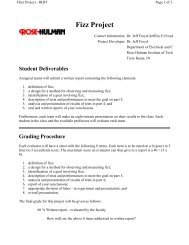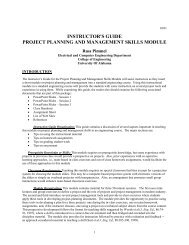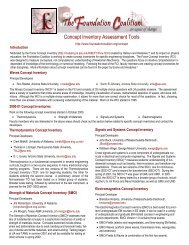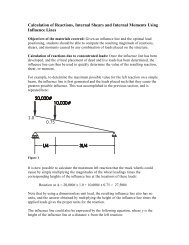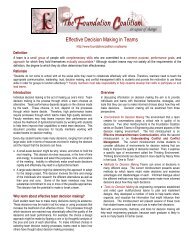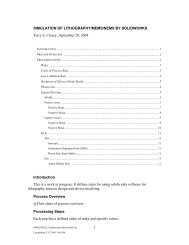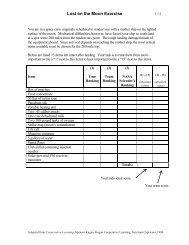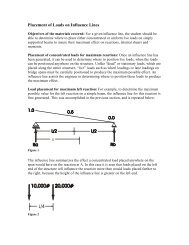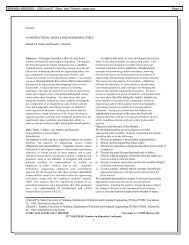Peer Assessment and Peer Evaluation - Foundation Coalition
Peer Assessment and Peer Evaluation - Foundation Coalition
Peer Assessment and Peer Evaluation - Foundation Coalition
Create successful ePaper yourself
Turn your PDF publications into a flip-book with our unique Google optimized e-Paper software.
<strong>Peer</strong> <strong>Assessment</strong> <strong>and</strong> <strong>Peer</strong> <strong>Evaluation</strong><br />
http://www.foundationcoalition.org<br />
Definition<br />
A team is a small group of people with complementary skills who are committed to a common purpose, performance goals, <strong>and</strong> an<br />
approach for which they hold themselves mutually accountable. 1 Although student teams may not satisfy all the requirements of the<br />
definition, the degree to which they do often determines their effectiveness.<br />
Introduction<br />
Instructors who use teams commonly assign projects or other tasks to teams outside of class. In <strong>Foundation</strong> <strong>Coalition</strong> (FC) workshops<br />
on teams, one of the more frequently asked questions about teams is how team assignments can be graded. One approach to grading<br />
team assignments is to give the same grade to every team member. However, giving every individual the same grade for a team<br />
assignment runs counter to the principle of individual accountability in cooperative learning. Further, it may reward <strong>and</strong> even encourage<br />
“hitchhiking” by some members of a team. However, determining individual grades for work products submitted by a team is a<br />
challenging task. One approach to obtain information that may be helpful in determining individual grades is peer assessment. To help<br />
faculty members in using peer assessment <strong>and</strong>/or peer evaluation in their classes, the following issues are addressed:<br />
• What is it? <strong>Peer</strong> assessment allows team members to<br />
assess other members of the team as well as themselves.<br />
<strong>Peer</strong> assessment provides data that might be used in<br />
assigning individual grades for team assignments.<br />
• Why might I use team assignments? Teams produce<br />
higher quality results <strong>and</strong> can improve learning.<br />
• What are the general issues to consider in using peer<br />
assessment? Give students rules the first day, have them<br />
assess each other, <strong>and</strong> provide feedback.<br />
• What is the quality of the evaluations of team members of<br />
each other? With practice, students assess each other<br />
consistently <strong>and</strong> fairly.<br />
• What are considerations for team grading? These include<br />
signature sheets, workload tables, assessments, evaluations,<br />
<strong>and</strong> bonus points.<br />
• What are examples of what teachers are doing in the<br />
classroom? Faculty members describe their peer<br />
assessment methods.<br />
What is it?<br />
<strong>Peer</strong> assessment or peer evaluation can mean many<br />
things—a means of raising the bar by exposing students<br />
to exceptionally good (or bad) solutions; peer grading of<br />
homework, quizzes, etc.; <strong>and</strong> an aid to improving team<br />
performance or determining individual effort <strong>and</strong><br />
individual grades on team projects. For the purposes of<br />
the present discussion, peer assessment or peer<br />
evaluation is a process in which faculty members adjust<br />
individual grades for team assignments by using data<br />
collected by asking team members to evaluate each<br />
team member. <strong>Peer</strong> assessment or peer evaluation is<br />
not the same as peer grading. Some references to peer<br />
grading are provided below.
Why might I use team assignments?<br />
The reasons for offering team assignments include<br />
student, faculty, <strong>and</strong> learning issues (see other<br />
reasons in the Introduction to Teams).<br />
Learning Issues<br />
• Teams come to faculty members with higherlevel<br />
questions, which implies that they have<br />
resolved the lower-level questions<br />
• Research on social dependence supports the<br />
assertion that positive interdependent groups<br />
produce higher quality results<br />
Student Issues<br />
• Allow students to gain experience working in a<br />
team (looks good on a résumé)<br />
• Make students more comfortable with using<br />
teams<br />
Faculty Issues<br />
• Make faculty members in subsequent classes<br />
less skeptical of student abilities<br />
• Grade fewer (50% to 25%) papers<br />
• Have peers grade with careful guidance some<br />
of the above papers (see below)<br />
What are the general issues to consider in using peer<br />
assessment?<br />
Issue 1: Tell them early<br />
Announce rules <strong>and</strong> format on the first day Many instructors h<strong>and</strong><br />
out copies of the forms used for assessment <strong>and</strong> evaluation with (or as<br />
a part of) the syllabus.<br />
Issue 2: Give them practice<br />
Do assessment before (it counts) evaluation Students usually have<br />
no experience with assessing or evaluating the work of peers (or often<br />
even their own work). Provide opportunities for them to assess other<br />
team members in situations in which their assessments do not affect<br />
project grades.<br />
Issue 3: Include feedback<br />
Allow improvement Most students (given honest feedback from<br />
peers) will improve performance <strong>and</strong> are more willing to give honest<br />
feedback to peers as they gain experience with assessment.<br />
What is the quality of the evaluations of team members of<br />
each other?<br />
Won’t they give everyone the same grade or over-rate their own<br />
performance?<br />
Experience indicates that both of these outcomes occur frequently in<br />
the first or second cycle of assessment; however, faced with (often<br />
unanimous) contrary feedback from their teammates, most students<br />
come to a more consistent <strong>and</strong> reasonable assessment in subsequent<br />
cycles. Research also indicates that peer assessment data can be<br />
effectively used in assigning individual grades. 1, 2<br />
One faculty member reported that the slacker students almost always<br />
report themselves as the weakest on the team . . . the difference is<br />
whether they contributed 95% (their report) or 50%–75% (the range<br />
assigned by their teammates).
What are considerations for team grading?<br />
Many tools are available when grading team assignments:<br />
• Signature blocks indicate who contributed to the assignment<br />
he team.<br />
• Workload/Percent-effort tables allow grade adjustment <strong>and</strong><br />
tracking of a team member’s workload<br />
• <strong>Peer</strong> assessments give students feedback <strong>and</strong> opportunities<br />
to improve performance before grading<br />
• <strong>Peer</strong> evaluations provide peer ratings of each team member<br />
that may serve as a multiplier on the team grade or can<br />
determine the team grade<br />
• Bonus points are given to other team members by each<br />
member<br />
Combinations of these tools are possible <strong>and</strong> sometimes<br />
desirable. As a general rule instructors may use signature blocks<br />
on individual assignments to either give the same grade or a<br />
zero. Use other methods to adjust semester or project<br />
average for individual performance.<br />
Assignment Cover Sheets<br />
Faculty members may require that each assignment include cover<br />
sheets with either a signature block or a workload table. Both of<br />
these indicate the extent to which individual members of the team<br />
contributed to the assignment <strong>and</strong> can be used to determine<br />
appropriate individual grades from the team assignment.<br />
Signature Blocks<br />
Team members signing the signature block may receive the<br />
same grade, whereas those who do not (or are not allowed to)<br />
sign the cover sheet may receive no credit for the assignment.<br />
Here are some suggestions:<br />
• Require a signature block on all team assignments. A<br />
signature means<br />
I did my share of the work, <strong>and</strong> I have a general<br />
underst<strong>and</strong>ing of the contents of the assignment<br />
• Students can decline to sign, or teams can refuse to let a<br />
member or members sign<br />
• Students who do not sign the cover sheet receive a grade of<br />
zero on the assignment<br />
Workload/Percent-effort Tables<br />
A workload table allows some members of the team to receive a<br />
greater (or lesser) share of the credit for the assignment. Some<br />
faculty members ask students to list percent effort for each<br />
individual, some ask for percent credit, <strong>and</strong> some ask students to<br />
divide the points for the assignment in the workload table. Here<br />
are some options:<br />
• Use student-assigned grades or percentages to adjust<br />
grades, including the option of a zero for exceptional<br />
individual effort. Typically, students are asked to fill in a table<br />
on the cover sheet, assigning percentages to each member<br />
of their team or distributing available points.<br />
• Often instructors require additional documentation for<br />
exceptionally high- (or low-) workload assignments.<br />
Announce the practices you will use early in the<br />
semester, practice them during the semester,<br />
<strong>and</strong> use them to reinforce the importance of<br />
individual responsibility to the team.<br />
<strong>Peer</strong> <strong>Assessment</strong>s<br />
If you use peer evaluations to provide data for adjusting individual<br />
grades, consider using peer assessments so students can practice<br />
evaluating team members. Let team members submit ratings of all<br />
team members to the faculty member. Then, the faculty member<br />
can review the team ratings <strong>and</strong> provide each student with feedback<br />
that can help them improve ratings of their peers. <strong>Peer</strong><br />
assessments allow the students to gain experience with giving <strong>and</strong><br />
receiving feedback <strong>and</strong> give them an opportunity to improve<br />
performance before it counts against their grades.<br />
<strong>Peer</strong> <strong>Evaluation</strong>s<br />
• Assigning individual grades can be done by having students<br />
directly assign grades or by using student evaluations of<br />
performance to determine individual grades.<br />
• Direct Assignment: The faculty member determines the overall<br />
team grade, but the team makes adjustments to the team grade<br />
to determine individual grades.<br />
• Faculty Adjustment: Count peer evaluation as a multiplier on<br />
the team grade. Typically, each student on a team of four might<br />
receive between 70% <strong>and</strong> 110% of the team grade (depending<br />
on peer evaluation). Brown offers a quantitative algorithm. 3<br />
Bonus Points<br />
Allow each student to assign a certain number of bonus points<br />
(usually 5) with the following restrictions:<br />
• A student can give points to anyone (sometimes limited to<br />
members of his/her team but can be anyone in the class, i.e.,<br />
the person who helped him/her the most)<br />
• Students cannot keep any points for themselves<br />
• Limit the maximum number of bonus points so that the effect on<br />
the overall score for each student is restricted.<br />
<strong>Peer</strong> Grading<br />
Those interested in peer grading are referred to Michaelsen <strong>and</strong><br />
Schultheiss, “Making Feedback Helpful,” The Organizational<br />
Behavior Teaching Review, 1988, 13 (1), pp. 109–113.<br />
There have been recent legal challenges to peer grading:<br />
http://www.nea.org/neatoday/0011/rights.html<br />
However, early in 2002 the U.S. Supreme Court overturned this<br />
challenge, ruling unanimously for peer grading:<br />
http://www.nassp.org/services/legal_peergrade.html<br />
Calibrated <strong>Peer</strong> Review (CPR) provides a creative solution to<br />
future court challenges. CPR is a program for networked<br />
computers that enables peers to anonymously evaluate frequent<br />
writing assignments. A calibration cycle normalizes the grading <strong>and</strong><br />
engages the students to spend more time reading about the topics<br />
(<strong>and</strong> the instructor less time assessing student writing):<br />
http://cpr.molsci.ucla.edu/
What are examples of what teachers are doing in the classroom?<br />
Faculty members have been using the FC assessment <strong>and</strong> evaluation methods. Here are helpful tips from four of them.<br />
Example 1: Jim Morgan, Texas A&M University<br />
(Jim-morgan@tamu.edu)<br />
Dr. Morgan assigns individual grades based on team effort in a<br />
first-year engineering class of 100 students as described below.<br />
• Use a signature block on all team assignments. A<br />
signature means:<br />
I did my share of the work, <strong>and</strong> I have a general<br />
underst<strong>and</strong>ing of the contents of the assignment.<br />
Students can decline to sign or teams can refuse to let<br />
members sign.<br />
All team members get the same grade on any single<br />
assignment, or, if a signature is missing from the<br />
assignment, those who do not sign get no credit.<br />
• Use peer assessment (including anonymous feedback)<br />
after each month to allow students to see themselves as<br />
others see them <strong>and</strong> to give an opportunity for improved<br />
performance.<br />
• Use peer evaluation to adjust semester-average team<br />
grades for individual students. The average grade on a<br />
team is the grade earned (<strong>and</strong> given) by the instructor.<br />
Example 2: P. K. Imbrie, Purdue University<br />
(imbrie@purdue.edu)<br />
Dr. Imbrie utilizes an automated (Web-based) version of the<br />
method described in Example 1 for assigning individual grades<br />
based on team effort in first-year engineering classes of 180 to<br />
475 students.<br />
Before students do the peer evaluation that will affect the final<br />
grade, they are assigned multiple reflective exercises such as:<br />
• How could you have improved your team’s performance?<br />
• How could others on your team have improved your team’s<br />
performance?<br />
Example 3: Terry Kohutek, Texas A&M University<br />
(t-kohutek@tamu.edu)<br />
Dr. Kohutek assigns individual grades based on team effort in a<br />
first-year engineering class of 100 students as follows:<br />
• Bonus points are distributed to each student at the end of<br />
the semester<br />
• A student cannot keep any points<br />
• Points must be distributed in integer amounts<br />
• Points can be given to any student in the class (based on<br />
which student most improved his/her performance this<br />
semester)<br />
• No student can receive more than 10 points<br />
• Points are applied to the final course grade<br />
Example 4: Russ Pimmel, University of Alabama<br />
(rpimmel@bama.ua.edu)<br />
Dr. Pimmel uses the following process in a senior-level course<br />
that includes a monthlong team design project. The course<br />
includes several components (essential when using peer<br />
evaluation in determining grades):<br />
• Some training in teams (at least 30 minutes discussing team<br />
roles, team dynamics, meeting strategies, <strong>and</strong> so on).<br />
• Required weekly progress reports in which each team member<br />
individually answers three multiple-choice questions asking if<br />
he/she achieved the week’s goals, spent adequate time, <strong>and</strong><br />
worked together as a team. Possible answers translate roughly<br />
into “yes,” “almost yes,” <strong>and</strong> “no.” Students are also asked to<br />
indicate any particular problem <strong>and</strong> to identify any<br />
noncontributing individual.<br />
• Meetings with teams that are making no progress or having<br />
problems, including a noncontributing member.<br />
At the project’s end, each team submits a report, <strong>and</strong> each student<br />
completes an individual quiz <strong>and</strong> an evaluation form asking him/her to<br />
distribute the “effort” among the team members on a percentage<br />
basis. Students rate each teammate against the rater’s expectations<br />
for that student, taking into account talent, background, <strong>and</strong> personal<br />
situations. The rater is to be fair <strong>and</strong> honest, not only because it the<br />
right thing to do, but also because, when working as professionals,<br />
he/she will evaluate peers; this provides practice for this skill.<br />
Percentages given to each student are combined to get an effort<br />
score.<br />
• Scores are simply averaged, or a “figure-skating” process is<br />
used (the highest <strong>and</strong> the lowest scores are dropped before<br />
averaging).<br />
Inconsistent scores are resolved in various ways, based on the<br />
professor’s personal knowledge of the students, by talking to them, or<br />
by giving everyone an equal-effort score.<br />
From the team report grade, the individual quiz grade, <strong>and</strong> effort<br />
scores, individual report grades <strong>and</strong> a team quiz grade are computed.<br />
The former is obtained by multiplying the team report grade by the<br />
individual effort scores <strong>and</strong> the latter by averaging the individual quiz<br />
grades using the effort scores as weighting factors.<br />
References for Further Information<br />
1. Kaufman, D.B., Felder, R.M., <strong>and</strong> Fuller, H. (2000), “Accounting for<br />
Individual Effort in Cooperative Learning Teams,” Journal of Engineering<br />
Education, 89(2), 133–140.<br />
2. Van Duzer, E., <strong>and</strong> McMartin, F. (1999), “Building Better Teamwork<br />
<strong>Assessment</strong>s: A Process for Improving the Validity <strong>and</strong> Sensitivity of<br />
Self/<strong>Peer</strong> Ratings,” Proceedings, ASEE Conference.<br />
3. Brown, R.W. (1995), "Autorating: Getting Individual Marks from Team Marks<br />
<strong>and</strong> Enhancing Teamwork," Proceedings, FIE Conference.<br />
http://www.eas.asu.edu/~asufc/teaminginfo/teams.html<br />
http://www.uoregon.edu/~bartj/pae/peer-eval.html<br />
http://arapaho.nsuok.edu/~legatski/4213<strong>Peer</strong>.htm<br />
http://iluvatar.lcps.k12.nm.us/manual/eval/peer.html<br />
Whether you are just getting started or looking for additional ideas on peer assessment, peer evaluation, or student teams in general,<br />
the <strong>Foundation</strong> <strong>Coalition</strong> offers workshops, lesson plans, <strong>and</strong> reading materials. For suggestions on where to start, see our Web site at<br />
http://www.foundationcoalition.org or contact Jeffrey Froyd at froyd@ee.tamu.edu or 979.845.7574.




